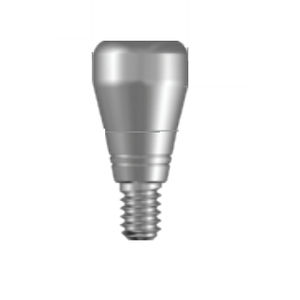
- Dental
- Dental practice
- Titanium transfer abutment
- UFIT IMPLANT

- Products
- Catalogs
- News & Trends
- Exhibitions
Titanium transfer abutment straight
Add to favorites
Compare this product
Characteristics
- Material
- titanium
- Configuration
- straight
- Implant diameter
4 mm, 4.5 mm
(0.16 in, 0.18 in)- Implant length
11 mm, 15 mm
(0.43 in, 0.59 in)
Description
Method
- Use 1.2 hex driver
Components
- impression coping + guide pin
- 10mm/15mm/20mm guide pin size
Usage
- Use of custom tray
- Increases the ease of various guide pin size
Conventional Abutment and sylbutment
The principles of
The principles of SYLBUTMENT are easily discovered around us.
In a conventional abutment, the gap between fixture and abutment may increase gradually due to repeated chewing forces. This is due to the contact between the outer surface
of the abutment and the inner taper of the fixture, which only occurs on a small surface
area due to the roughness of both the two surfaces. On the other hand, SYLBUTMENT
increases the contact surfaces by transformation to the grooves. It does not create a gap
as the transformation between the two surfaces occurs within the elastic range.
Why does loosening occur in conventional abutments?
The perfect contact of two at surfaces is only possible theoretically but practically impossible.
The perfect contact of two at surfaces is only possible
theoretically but practically impossible.
When a chewing force is applied then removed,
the gap between the two surfaces increase.
As shown in the figure above, chewing forces are experienced asymmetrically
due to the grooves of the SYLBUTMENT acting as an elastic body. This firmly
maintains the sealed state of the abutment and distributes the chewing forces
evenly in the fxture
Catalogs
No catalogs are available for this product.
See all of UFIT IMPLANT‘s catalogsExhibitions
Meet this supplier at the following exhibition(s):

Related Searches
- Implant abutment
- Titanium implant abutment
- Straight implant abutment
- Internal implant abutment
- Dental implant
- Titanium dental implant
- Hexagonal implant abutment
- Angulated implant abutment
- Screw implant abutment
- Dental implant analog
- Tapered dental implant
- Straight dental implant analog
- Gingiva former
- Internal hexagon dental implant
- Impression cap
- Hexagonal dental implant
- Titanium gingiva former
- Cemented implant abutment
- Narrow implant abutment
- Straight gingiva former
*Prices are pre-tax. They exclude delivery charges and customs duties and do not include additional charges for installation or activation options. Prices are indicative only and may vary by country, with changes to the cost of raw materials and exchange rates.



